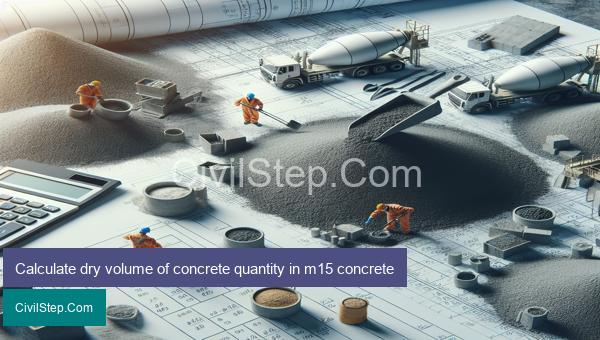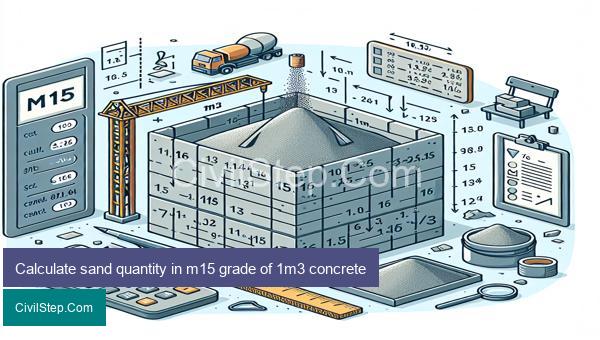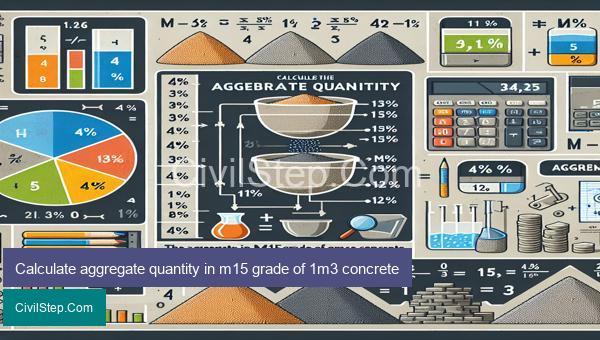
Concrete is the most widely used building material across the world, and cement, sand, and aggregate are the basic components that make up this versatile material. Among these three, cement plays a crucial role in providing strength and durability, while sand and aggregate provide volume and support. When it comes to constructing a structure, the mix proportions of these materials play a significant role, as it directly affects the quality and strength of the concrete. In this article, we will delve into the details of M15 concrete, which is commonly used for residential construction, and explore the crucial aspect of cement, sand, and aggregate quantity in 1m3 of M15 concrete.
Cement sand and aggregate quantity in m15 of 1m3 concrete

Cement, sand, and aggregate are the essential components of concrete and are responsible for its strength and durability. In the M15 grade of concrete, the proportion of these materials is 1:2:4, which means that for every 1 part of cement, 2 parts of sand and 4 parts of aggregate are used.
1. Cement:
Cement is the binding material in concrete and is responsible for holding the construction material together. The standard measurement for the quantity of cement is in bags. In 1m3 of M15 concrete, the quantity of cement required is approximately 6.5 bags of 50kg each.
2. Sand:
Sand is one of the major components of concrete and is used to provide bulk and enhance workability. The standard measurement for sand is in cubic feet. In 1m3 of M15 concrete, the quantity of sand required is approximately 1150 kg, which is equivalent to 23 cubic feet.
3. Aggregate:
Aggregate provides strength and stability to the concrete. It is available in various sizes, such as fine, coarse, and gravel. The standard measurement for the quantity of aggregate is in cubic feet. In 1m3 of M15 concrete, the quantity of coarse aggregate required is approximately 2300 kg, which is equivalent to 46 cubic feet.
It should be noted that the above-mentioned quantities are for a nominal mix of M15 grade concrete. However, the actual ratio may vary based on the quality of materials used and the specific requirements of the project. It is always advisable to conduct a trial mix to determine the exact proportions of materials needed for the desired strength and workability.
In conclusion, the quantity of cement, sand, and aggregate required in 1m3 of M15 concrete is 6.5 bags, 23 cubic feet, and 46 cubic feet, respectively. It is crucial to use good quality materials and maintain the correct proportions to achieve the desired strength and durability of the concrete.
Calculate dry volume of concrete quantity in m15 concrete

M15 concrete is a type of concrete with a compressive strength of 15 megapascals (MPa). It is commonly used in residential and commercial construction projects. As a civil engineer, one of the important tasks is to determine the quantity of materials needed for a specific project. In this article, we will discuss how to calculate the dry volume of M15 concrete.
Dry volume is the volume of concrete after it has been completely mixed with all the ingredients and before adding water. It is important to calculate the dry volume accurately as it helps in determining the correct amount of materials needed for the desired strength and durability of the concrete.
To calculate the dry volume of M15 concrete, we need to follow the below steps:
Step 1: Determine the volume of concrete required
The first step is to determine the volume of concrete needed for the project. This can be done by referring to the project drawings or by calculating the area and thickness of the concrete surface to be constructed.
Let’s assume that we need to construct a concrete slab of 10 meters (m) length, 8m width, and 0.15m thickness.
So, Volume of concrete = Length x Width x Thickness
= 10m x 8m x 0.15m
= 12 m^3
Step 2: Consider the shrinkage factor
When concrete dries, it undergoes shrinkage due to the loss of moisture. This causes a decrease in its volume. The shrinkage factor for M15 concrete is taken as 1.54.
So, the total volume of concrete needed will be:
Total volume = 12 m^3 x 1.54
= 18.48 m^3
Step 3: Calculate the dry volume
The next step is to calculate the dry volume using the following formula:
Dry volume = Total volume of concrete x (1+percentage of sand) x (1+ 3/5 x percentage of water)
In M15 concrete, the ratio of cement, sand, and aggregates is 1:2:4. So, the percentage of sand in the mix is 2/(1+2+4) = 0.25, and the percentage of water is 0.55 as per the strength of the mix.
Dry volume = 18.48 m^3 x (1+ 0.25) x (1+3/5 x 0.55)
= 18.48 m^3 x 1.25 x 1.33
= 30.96 m^3
Therefore, the dry volume of M15 concrete for the given project is 30.96 m^3.
It is important to note that the dry volume calculated using this formula is only an estimation and may vary depending on the type of aggregates and their moisture content.
In conclusion, as a civil engineer, it is essential to accurately calculate the dry volume of concrete to ensure the right amount of materials are used in construction. This not only helps in controlling the cost but also ensures the desired strength and durability of the structure.
Calculate cement quantity in m15 concrete

M15 concrete is a commonly used grade of concrete in construction. It has a compressive strength of 15 MPa (megapascals) after 28 days of curing. To ensure the strength and quality of the concrete, it is essential to calculate the correct quantity of ingredients used in its preparation. Cement, being a major component of concrete, plays a crucial role in achieving the desired strength and durability.
So, how do we calculate the cement quantity in M15 concrete? There are two methods of calculating the cement quantity – the weight method and the volume method. Let’s take a look at both methods.
1. Weight Method:
In the weight method, we use the density of cement to calculate the cement quantity. The density of cement is approximately 1440 kilograms per cubic meter (kg/m^3). Let’s assume we need to prepare 1 cubic meter (m^3) of M15 concrete with a mix ratio of 1:2:4 (1 part cement, 2 parts fine aggregate, and 4 parts coarse aggregate).
Step 1: Calculate the volume of cement
Volume of cement = (1/7) x 1 m^3 = 0.143 m^3
Step 2: Calculate the weight of cement
Weight of cement = volume of cement x density of cement = 0.143 m^3 x 1440 kg/m^3 = 205.92 kg
Therefore, the cement quantity required for 1 m^3 of M15 concrete is 205.92 kg.
2. Volume Method:
In the volume method, we use the unit weight of cement to calculate the cement quantity. The unit weight of cement is approximately 1440 kilograms per cubic meter (kg/m^3), which means 1 kg of cement occupies a volume of 1/1440 = 0.000694 m^3. Let’s use the same mix ratio of 1:2:4 and assume we need to prepare 1 cubic meter of M15 concrete.
Step 1: Calculate the volume of cement
Volume of cement = (1/7) x 1 m^3 = 0.143 m^3
Step 2: Calculate the unit weight of cement
Unit weight of cement = (1/1440) x 205.92 kg = 0.143 kg
Therefore, the cement quantity required for 1 m^3 of M15 concrete is 205.92 kg.
It is important to note that the above calculations are based on the assumption that the materials used are dry. In reality, the moisture content in the materials affects their weight and volume. Hence, the above calculations may vary depending on the actual moisture content of the materials used.
Moreover, it is always recommended to add a little extra cement quantity (around 10%) to compensate for any errors in the measurement or for the variations in the materials. This will help in achieving the desired strength and durability of the concrete.
In conclusion, calculating the cement quantity in M15 concrete involves some simple steps and can be done using either the weight or volume method. However, it is crucial to accurately measure and include the amount of cement required for the best results.
Calculate sand quantity in m15 grade of 1m3 concrete

In construction, concrete is one of the most widely used materials. It is a mixture of cement, sand, gravel or crushed stone, and water. The proportions of these ingredients determine the strength and durability of the concrete. One of the commonly used concrete grades is M15, which refers to the mix ratio of 1:2:4 (cement:sand:aggregate) by volume. In this article, we will discuss how to calculate the quantity of sand required for 1m3 (cubic meter) of M15 grade concrete.
Steps to Calculate Sand Quantity in M15 Grade Concrete:
Step 1: Determine the Total Volume of Concrete
The first step to calculating the sand quantity is to determine the total volume of concrete required. In this case, we are considering 1m3 of M15 grade concrete. This means that the total volume of concrete is also 1m3.
Step 2: Determine the Volume of Coarse Aggregate
The next step is to determine the volume of coarse aggregate for the given concrete mix. Since the ratio of aggregate to cement is 2:4, the volume of coarse aggregate will be 2/6 (or 1/3) of the total volume of concrete. Therefore, the volume of coarse aggregate in 1m3 of M15 concrete is 1/3m3.
Step 3: Determine the Volume of Cement
Similarly, the volume of cement can be calculated by multiplying the total volume of concrete by the ratio of cement to the sum of all ingredients, i.e. 1/6 (or 1/2 x 1/3). For 1m3 of M15 concrete, the volume of cement is 1/6m3.
Step 4: Calculate the Volume of Sand
Now that we have determined the volumes of coarse aggregate and cement, we can calculate the volume of sand. The volume of sand in 1m3 of M15 concrete is the remaining 1/2m3 (1m3 – 1/3m3 – 1/6m3 = 1/2m3). This means that for every 1m3 of M15 concrete, we need 1/2m3 of sand.
Step 5: Convert Volume to Mass
To calculate the quantity of sand in kilograms, we need to convert the volume in cubic meters to mass in kilograms. The density of sand varies but is typically around 1600 kg/m3. So, the mass of sand required for 1m3 of M15 concrete is 1/2 x 1600 = 800kg.
In conclusion, for 1m3 of M15 grade concrete, we need 800kg of sand. It is important to note that this is an estimation and the actual quantity of sand required may vary depending on factors such as the moisture content of sand, its fineness, and the degree of compaction. To ensure accuracy, it is always recommended to consult a professional engineer or use a concrete mix design calculator. Proper estimation of materials is crucial in achieving a high-quality and durable concrete structure.
Calculate aggregate quantity in m15 grade of 1m3 concrete

M15 grade of concrete is a standard mix design used for general construction purposes. It is a medium strength concrete with a compressive strength of 15 MPa (megapascals) after 28 days of curing. The mix proportion for M15 grade concrete is 1:2:4, which means that for every 1 part of cement, 2 parts of sand and 4 parts of coarse aggregate are used.
Calculation of aggregate quantity in M15 grade concrete can be done in the following steps:
Step 1: Determine the volume of concrete required:
To calculate the volume of concrete required, we need to first determine the volume of 1 cubic meter (m3). 1 m3 is equal to 1000 liters. Therefore, the volume of 1 m3 concrete is 1000 liters.
Step 2: Determine the proportion of materials:
As mentioned earlier, the mix proportion for M15 grade concrete is 1:2:4. So, 1 cubic meter of concrete requires:
1 part of cement: 1/7 x 1000 liters = 143 liters
2 parts of sand: 2/7 x 1000 liters = 286 liters
4 parts of coarse aggregate: 4/7 x 1000 liters = 572 liters
Step 3: Calculate the volume of loose ingredient:
Since the ingredients are in a loose state, they occupy more volume than their solid state. This is known as the bulking of sand. The bulking factor for sand is taken as 1.3. So, the volume of loose sand is:
286 liters x 1.3 = 372 liters
Step 4: Determine the mass of ingredients:
The density of cement is 1440 kg/m3 and the density of sand and coarse aggregate is 1600 kg/m3. So, the masses of the ingredients are:
Cement = 143 liters x 1440 kg/m3 = 206 kg
Sand = 372 liters x 1600 kg/m3 = 595 kg
Coarse aggregate = 572 liters x 1600 kg/m3 = 915 kg
Step 5: Adjust for moisture content:
The aggregate used in concrete may contain some moisture, which will affect its weight. This must be accounted for in the calculation by adding an additional 3% to the mass of sand and coarse aggregate.
Adjusted mass of sand = 595 kg + (595 kg x 3/100) = 613 kg
Adjusted mass of coarse aggregate = 915 kg + (915 kg x 3/100) = 943 kg
Step 6: Calculate the total volume of aggregate:
The total volume of aggregate is the sum of the volumes of coarse aggregate and sand.
Total volume of aggregate = 613 liters + 943 liters = 1556 liters
Therefore, for 1 cubic meter of M15 grade concrete, the aggregate quantity required is 1556 liters.
In conclusion, calculating the aggregate quantity in M15 grade concrete involves determining the volume of required concrete, proportioning the materials, adjusting for bulking and moisture content, and calculating the total volume of aggregate. Accurate calculation is crucial for achieving the desired strength and durability of the concrete structure.
Conclusion
In conclusion, understanding the correct proportions of cement, sand, and aggregate in a concrete mix is crucial for creating high-quality and durable structures. In the case of M15 concrete mix, the recommended ratio of cement:sand:aggregate is 1:2:4. While there may be slight variations depending on the specific project and environment, following this ratio will ensure the desired strength and consistency in the concrete. Additionally, it is important to use good quality materials and to properly mix and cure the concrete for optimal results. With this knowledge, you can confidently embark on your next construction project knowing the key factors to consider for a successful and strong concrete mix. Properly understanding cement, sand, and aggregate quantities in M15 concrete will not only save
